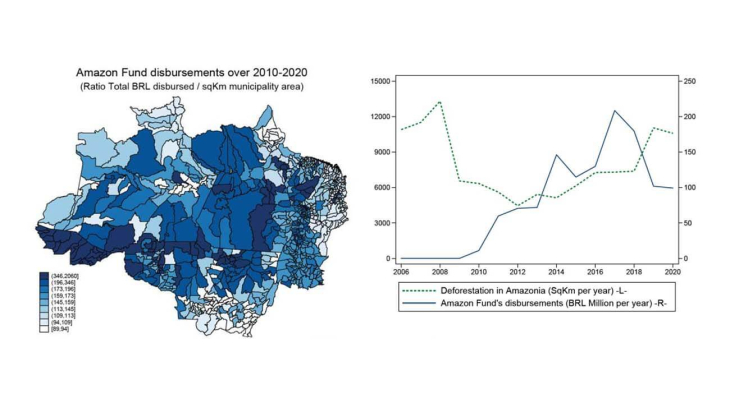This paper investigates whether green finance—specifically through the Amazon Fund—has helped reduce deforestation in the Brazilian Amazon. The Amazon rainforest is crucial for regulating Earth’s climate, but rising deforestation, especially since 2019, has turned parts of it into a net source of carbon emissions rather than a carbon sink. To fight rainforest clearing, the Amazon Fund was set up in 2009 as Brazil’s main international climate finance tool. Primarily funded by Norway and Germany, it supports projects in Brazil's Legal Amazon region. Its disbursements have been steadily increasing up to 2017, then have sharply declined.
We use economic and satellite data from 760 municipalities between 2002 and 2020 to assess how Amazon Fund disbursements, government enforcement actions, and agricultural activity affect deforestation. We apply an econometric method (PVAR—Panel Vector Auto Regression) that enable capture the complex interactions between these variables over time. Our empirical findings yield insights for policy-makers and green funders.
The first set of policy implications is related to the role of agricultural activities. Agricultural output growth entails higher rates of rainforest clearing. When analysing the separate role of agricultural commodities, wood production shows a more clear-cut impact on deforestation than cattle ranching or soybean production. Controlling illegal logging and wood smuggling and, ultimately, promoting alternative materials to reduce the international demand for timber is crucial in the fight for deforestation.
Second, monitoring efforts need proper law enforcement mechanisms to be effective against deforestation. Blacklisting municipalities, combined with economic incentives to exit the blacklist, helps to slow down deforestation.
Third (and main) set of policy conclusions: properly designed green finance manages to reduce significantly deforestation rates. The action of the Amazon Fund interacts with (and works through) other key factors. Green finance, agricultural productivity, and law enforcement may benefit from important synergies. i/ Promoting agricultural productivity (in terms of per capita agricultural output) rather than extensive use of new lands helps to enhance the efficacy of green finance in fighting deforestation. This has to be balanced by a control of local pollution, to the extent that biodiversity may be harmed by pesticides, fertilizers, etc. ii/ Some of the Funds’ main successful projects, such as those related to monitoring and control systems or to the enforcement of the Forest code through the Rural Environmental Registry (CAR), facilitate the action of environmental agencies. iii/ At a more disaggregated level, some types of projects need relatively less funding to fight deforestation. By recipient, projects managed at the federal or state level are more efficient than those managed by municipalities. This is probably due to the taxonomy of the projects, rather than to the level of governance. Federal government and states’ projects are to a large extent related to actions that yield immediate gains against deforestation, such as monitoring, enforcing environmental regulation (CAR) and fighting illegal fires. In turn, tools that fight deforestation rather in the long run or that specifically target the recovery of biodiversity, such as fostering sustainable production or science & innovation activities, are typically led by the third sector (eg. NGOs, foundations) and universities. Our findings do not call for a public top-down approach in the allocation of disbursements, though. Land use planning, which is the most efficient axis, corresponds to projects most often led by the third sector and aimed at empowering local autochthonous communities in protected areas. Strengthening the social roots in indigenous lands is thus a highly efficient way to fight against rainforest clearing.
Last the Amazon Fund is a relatively “cheap” green finance tool: ultimately, it manages to reduce emissions from deforestation at a low cost per saved ton of carbon dioxide.
In all, this research fills a key gap by providing the first overall quantitative evidence that the Amazon Fund works, and that international climate finance can support effective environmental protection—if backed by political will.
Keywords: Green finance, Deforestation, Amazon rainforest, Panel-VAR
Codes JEL : C33, C81, F35, Q20, Q54, Q56
